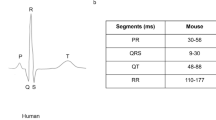Abstract
In vivo electrophysiology remains a suitable method to monitor cardiac activity; however, surface electrocardiogram (ECG) monitoring remains complicated in the case of small animals. Sedation has helped to maintain the animal still; however, it is known that anesthetic drugs impair the regulation of the cardiac electrical activity. To circumvent this problem, ECG monitoring using telemetry or restraints has been developed. This study reports a new methodology, based on a restraining system without further sedation, for recording ECGs on small animal models. We investigated its efficacy in Syrian hamsters and in several strains of mice, and we compared these data to those obtained with telemetry devices. We show that this new system can easily be used in animals of different sizes ranging from adult hamsters to newborn mice. When compared to telemetry, this restrained ECG monitoring method shows a very good yield, as 65% of total beats can be used for further analysis. When recorded in the same animals, RR intervals distributions are identical for both techniques. In conclusion, this restrained ECG monitoring technique is a well-suited tool for exploring various aspects of cardiac electrophysiology in a wide variety of small animals including very young mice.





Similar content being viewed by others
References
Berul CI, Aronovitz MJ, Wang PJ, Mendelsohn ME (1996) In vivo cardiac electrophysiology studies in the mouse. Circulation 94(10):2641–2648
Berul CI, Christe ME, Aronovitz MJ, Seidman CE, Seidman JG, Mendelsohn ME (1997) Electrophysiological abnormalities and arrhythmias in alpha MHC mutant familial hypertrophic cardiomyopathy mice. J Clin Invest 99(4):570–576
Chu V, Otero JM, Lopez O, Morgan JP, Amende I, Hampton TG (2001) Method for non-invasively recording electrocardiograms in conscious mice. BMC Physiol 1:6
Doevendans PA, Daemen MJ, de Muinck ED, Smits JF (1998) Cardiovascular phenotyping in mice. Cardiovasc Res 39(1):34–49
Gehrmann J, Hammer PE, Maguire CT, Wakimoto H, Triedman JK, Berul CI (2000) Phenotypic screening for heart rate variability in the mouse. Am J Physiol Heart Circ Physiol 279(2):H733–H740
Goldbarg AN, Hellerstein HK, Bruell JH, Daroczy AF (1968) Electrocardiogram of the normal mouse, Mus musculus: general considerations and genetic aspects. Cardiovasc Res 2(1):93–99
Hamlin RL, Kijtawornrat A, Keene BW, Hamlin DM (2003) QT and RR intervals in conscious and anesthetized guinea pigs with highly varying RR intervals and given QTc-lengthening test articles. Toxicol Sci 76(2):437–442
Hongo M, Ryoke T, Ross J (1997) Animal models of heart failure-recent developments and perspectives. Trends Cardiovasc Med 7(5):161–167
James JF, Hewett TE, Robbins J (1998) Cardiac physiology in transgenic mice. Circ Res 82(4):407–415
Kirchhof P, Fabritz L, Fortmuller L, Matherne GP, Lankford A, Baba HA, Schmitz W, Breithardt G, Neumann J, Boknik P (2003) Altered sinus nodal and atrioventricular nodal function in freely moving mice overexpressing the A1 adenosine receptor. Am J Physiol Heart Circ Physiol 285(1):H145–H153
Kramer K, Kinter L, Brockway BP, Voss HP, Remie R, Van Zutphen BL (2001) The use of radiotelemetry in small laboratory animals: recent advances. Contemp Top Lab Anim Sci 40(1):8–16
Kramer K, Kinter LB (2003) Evaluation and applications of radiotelemetry in small laboratory animals. Physiol Genomics 13(3):197–205
Kramer K, van Acker SA, Voss HP, Grimbergen JA, van der Vijgh WJ, Bast A (1993) Use of telemetry to record electrocardiogram and heart rate in freely moving mice. J Pharmacol Toxicol Methods 30(4):209–215
Mitchell GF, Jeron A, Koren G (1998) Measurement of heart rate and Q–T interval in the conscious mouse. Am J Physiol 274(3 Pt 2):H747–H751
Robineau P (1988) A simple method for recording electrocardiograms in conscious, unrestrained rats. J Pharmacol Methods 19(2):127–133
Royer A, van Veen TA, Le Bouter S, Marionneau C, Griol-Charhbili V, Leoni AL, Steenman M, van Rijen HV, Demolombe S, Goddard CA, Richer C, Escoubet B, Jarry-Guichard T, Colledge WH, Gros D, de Bakker JM, Grace AA, Escande D, Charpentier F (2005) Mouse model of SCN5A-linked hereditary Lenegre’s disease: age-related conduction slowing and myocardial fibrosis. Circulation 111(14):1738–1746
Wang L, Swirp S, Duff H (2000) Age-dependent response of the electrocardiogram to K(+) channel blockers in mice. Am J Physiol Cell Physiol 278(1):C73–C80
Wehrens XH, Kirchhoff S, Doevendans PA (2000) Mouse electrocardiography: an interval of thirty years. Cardiovasc Res 45(1):231–237
Author information
Authors and Affiliations
Corresponding author
Rights and permissions
About this article
Cite this article
Mongue-Din, H., Salmon, A., Fiszman, M.Y. et al. Non-invasive restrained ECG recording in conscious small rodents: a new tool for cardiac electrical activity investigation. Pflugers Arch - Eur J Physiol 454, 165–171 (2007). https://doi.org/10.1007/s00424-006-0197-8
Received:
Accepted:
Published:
Issue Date:
DOI: https://doi.org/10.1007/s00424-006-0197-8




